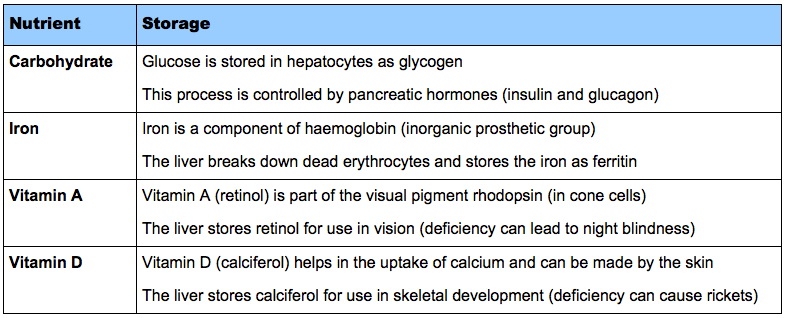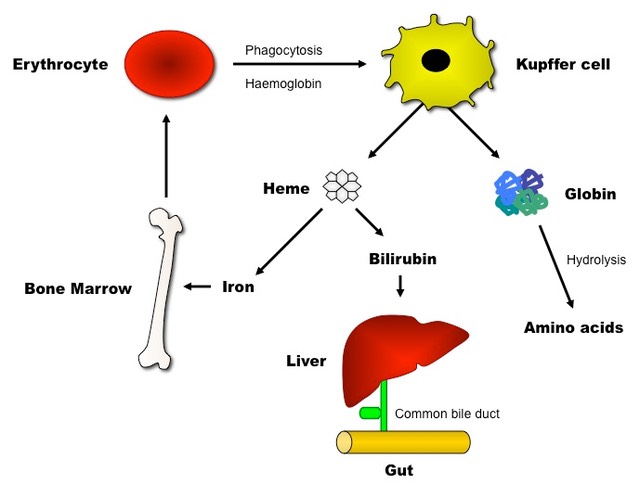H.4.1 Outline the circulation of blood through liver tissue, including the hepatic artery, hepatic portal vein, sinusoids and hepatic vein
- The liver is divided into segments called lobules which contain liver cells (hepatocytes)
- Each lobule is surrounded by branches of the hepatic artery and the hepatic portal vein
- The hepatic artery carries oxygenated blood from the heart to the liver
- The hepatic portal vein carries nutrient-laden blood from the intestines
- The hepatic artery and hepatic portal vein both connect to blood vessels called sinusoids
- The sinusoids drain into a central vein, which feeds into the hepatic vein
- The hepatic vein carries deoxygenated blood from the liver to the heart
Overview of the Circulation of Blood via the Liver

![]() Structure of a Liver Lobule
Structure of a Liver Lobule
H.4.2 Explain the role of the liver in regulating levels of nutrients in the blood
- Many substances in the blood need to be kept within homeostatic limits to prevent damaging effects
- Sugar and salt levels need to be controlled in order to maintain the osmolarity of the blood and surrounding tissue
- Amino acids cannot be stored by the body and must be detoxified when in excess
- Many minerals and vitamins are essential for specific biological processes (e.g. vitamin A and vision), and so must be sequestered when not in use
- Absorbed nutrients pass through the liver (via the hepatic portal vein) prior to entering general circulation
- This enables the liver to regulate and maintain viable levels of nutrients in the blood in spite of variations in dietary intake and feeding frequency
- The liver stores excess glucose as glycogen granules within hepatocytes, and digests this glycogen when blood glucose levels are low
- The liver is responsible for the deamination of excess amino acids (made into ammonia before being converted into urea)
H.4.3 Outline the role of the liver in the storage of nutrients, including carbohydrate, iron, vitamin A and vitamin D

H.4.4 State that the liver synthesises plasma proteins and cholesterol
The liver synthesis cholesterol, which is involved in bile production and is a component of animal cell membranes
The liver is also involved in the synthesis of plasma proteins, which serve a variety of roles
- Albumin – helps regulate osmotic pressure of body fluids
- Fibrinogen – soluble precursor of the clotting protein fibrin
H.4.5 State that the liver has a role in detoxification
Detoxification is the removal of a toxic substance from a living organism
The liver plays a role in the detoxification of a number of molecules, including alcohol, metabolic products, food preservatives, drugs and poisons
H.4.6 Describe the process of erythrocyte and hemoglobin breakdown in the liver, including phagocytosis, digestion of globin and bile pigment formation
- Erythrocytes rupture when they reach the end of their life span (~ 120 days)
- Kupffer cells are phagocytes found within the sinusoid lumen which engulf the contents and break down haemoglobin into globin and heme groups
- Globin is digested by peptidases to produce amino acids (which are either used in the synthesis of new proteins or metabolised by the liver)
- Heme groups are broken down into iron and bilirubin (bile pigment)
- The iron is transported to either the liver (for storage) or the bone marrow (to make new blood cells)
- The bilirubin is transported to the liver to be released as part of bile into the alimentary canal
Process of Erythrocyte and Haemoglobin Breakdown

H.4.7 Explain the liver damage caused by excessive alcohol consumption
- Alcohol is metabolised by the liver to form products that may be toxic to cells (alcohol consumption also reduces cellular antioxidant activity)
- This leads to the replacement of healthy liver cells with fibrous scar tissue, which reduces the liver's ability to:
- Metabolise the body's supply of carbohydrates, fats and proteins
- Produce bile and remove toxins from the body
- Transport materials around the body (blocks blood flow to and from liver)
- Over time this may lead to nutritional deprivation and an increased susceptibility to infection

Long term alcohol abuse (i.e. excessive drinking) results in three primary effects upon the liver:
1. Inflammation – swelling of damaged liver tissue (sometimes called alcoholic hepatitis)
2. Fat accumulation – build up of fat in place of normal liver tissue
3. Cirrhosis – scar tissue left when areas of liver are destroyed by prolonged alcohol exposure